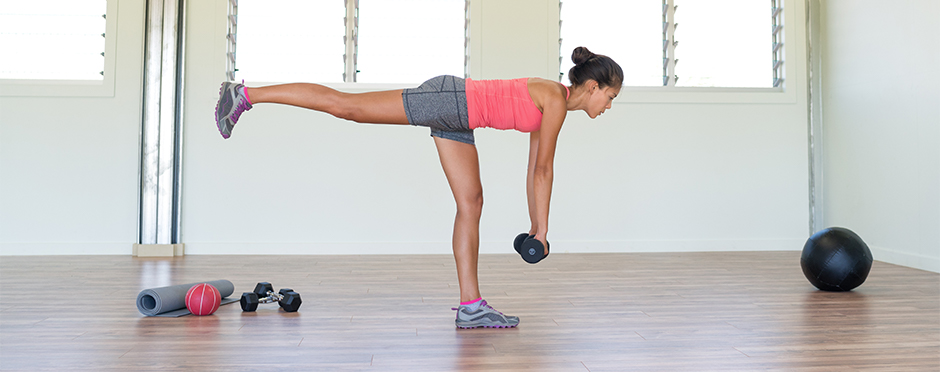
5 Ways to Improve Your Balance
Leave a CommentBalance is observed in many aspects of life. An elite running back, a waitress, and even Grandma Sally all need good balance. A running back uses balance to stay on his feet and avoid defenders, whereas a waitress uses balance to carry food and weave in between guests. Grandma Sally uses her balance to navigate the grocery store or to walk to her mailbox. Balance plays a crucial role in avoiding falling and completing tasks throughout the day.
Balance uses visual, proprioceptive, and vestibular systems to work together to optimize the ability to balance. 1 If one of these systems is impaired, the ability to balance becomes increasingly difficult and can lead to falling.
The method of improving balance may look different for the three individuals mentioned previously, but the underlying principle remains the same. Enhance the visual, proprioceptive, and vestibular systems, and balance is enhanced. For Grandma Sally improving balance has also been shown to reduce the risk of falling in older adult populations.2
Below are five balance exercises that can improve balance while using little to no equipment.
Exercises to Improve Balance
1. Tandem stance – walk forward, placing one foot’s heel in front of the other in contact with the toes—alternate steps with the feet moving forward.
- Progression – repeat the instructions listed above and close the eyes while balancing.
- Progression – repeat the instructions listed above and stand on an unstable surface such as a pillow while balancing.
2. Tandem walking – walk forward placing the heel of one foot in front of the other in contact with the toes. Alternate steps with the feet moving forward.
- Progression – repeat the instructions listed above and close the eyes while walking. Be sure to perform this in an open area, free of clutter.
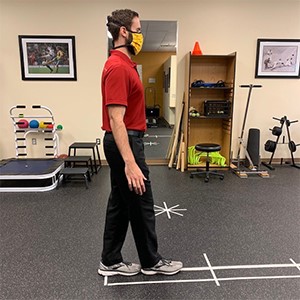
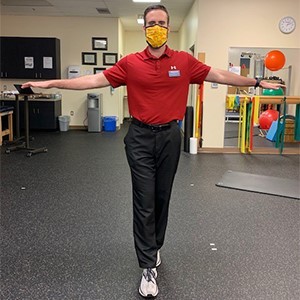
3. Single limb stance – stand with the arms relaxed and the feet together on the floor. Lift one foot from the floor and balance on the opposite leg.
- Progression – repeat the instructions listed above and close the eyes while balancing.
- Progression – repeat the instructions listed above and stand on an unstable surface such as a pillow while balancing.
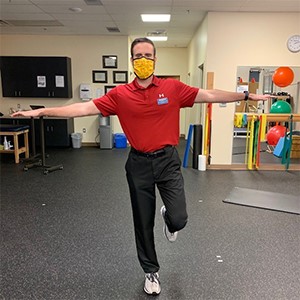
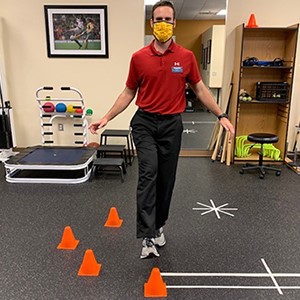
4. Single limb stance with reaches – stand with the arms relaxed and the feet together on the floor. Lift one foot from the floor and reach forward with that leg; without placing the foot back on the floor, return to the starting position. Repeat with the same leg reaching forward at a 45-degree angle, directly to the side, backward at a 45-degree angle, and straight back. Repeat on the other leg.
- Progression – repeat the instructions listed above and stand on an unstable surface such as a pillow while balancing.
5. Single Limb Romanian Deadlift – stand with the feet shoulder-width apart with a slight bend in both knees. Lift one foot off the floor. While reaching back with this leg, lean forward at the waist and reach the arms forward. Return to the starting position. Repeat on the other leg.
- Progression – repeat the instructions listed above and stand on an unstable surface such as a pillow while balancing.
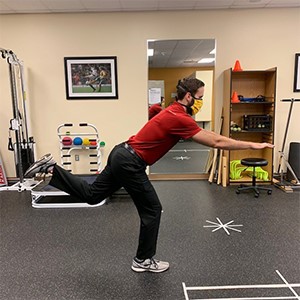
Reduce Your Risk of Falling with Physical Therapy
By improving your balance, you can help minimize your risk of falling. If you’re having difficultly with your balance, schedule a Free Assessment at an Athletico clinic near you. Our team can keep you on your feet by providing exercises or an individualized plan to improve your balance. Free Assessments are available in-clinic and virtually through our Telehealth platform.
Physical therapy is usually the thing you are told to do after medication, x-rays or surgery. The best way to fix your pain is to start where you normally finish – with physical therapy at Athletico.
The Athletico blog is an educational resource written by Athletico employees. Athletico bloggers are licensed professionals who abide by the code of ethics outlined by their respective professional associations. The content published in blog posts represents the opinion of the individual author based on their expertise and experience. The content provided in this blog is for informational purposes only, does not constitute medical advice and should not be relied on for making personal health decisions.
References
1. Lakie M, Loram ID. Manually controlled human balancing using visual, vestibular and proprioceptive senses involves a common, low frequency neural process. J Physiol. 2006;577(Pt 1):403‐416. doi:10.1113/jphysiol.2006.116772
2. Hafström A, Malmström EM, Terdèn J, Fransson PA, Magnusson M. Improved Balance Confidence and Stability for Elderly After 6 Weeks of a Multimodal Self-Administered Balance-Enhancing Exercise Program: A Randomized Single Arm Crossover Study. Gerontol Geriatr Med. 2016;2:2333721416644149. Published 2016 Apr 26. doi:10.1177/2333721416644149
